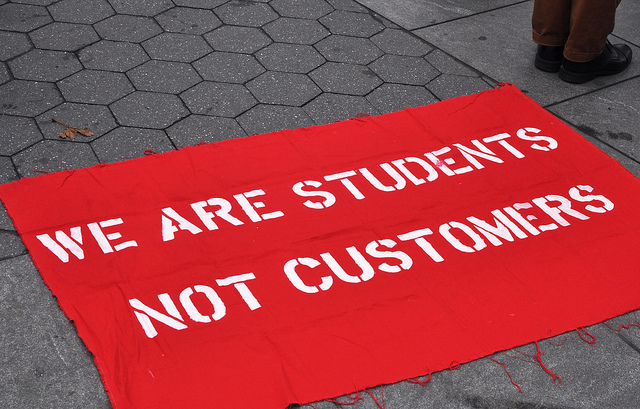The possible reality of free or reduced college tuition in America
There have been a few student-led protests against high tuition costs, which has contributed to the national debate on this issue.
Since the late 80s, college tuition prices at public four-year colleges have risen at about 3.8% annually, and 3% at two-year colleges. The rising prices of tuition have prompted a national debate to address them, which primarily centers around the proposal of “free college”.
Throughout the 2016 presidential campaign, several candidates included tuition pricing in their key issues, each with a different way to address it. Hillary Clinton’s plan extended to children of families with incomes of less than $125k per year, which would encumber 83% of families, while Sanders’ campaign estimated cost of free tuition for all at $75 billion and proposed taxes on Wall Street to cover this. Trump’s plan for tuition costs isn’t entirely clear, but at several points in his campaign he stressed lessening debt; he even at some points promised forgiveness past 15 years and a fixed payment rate of 12.5%.
However, free college has been strongly criticized by most right wing politicians and supporters, for a variety of reasons; the most prominent of these criticisms is the cost to national budget. Trump’s proposed budget posed a 13% decrease to the Department of Education, and, while it stated it “would focus on streamlining and simplifying funding for college, while continuing to help make college education more affordable”, it laid out little of a plan for this to be accomplished.
Several plans and means of achieving lower college debts have been proposed, ranging from free college to limited debt reduction plans. Financial aid is offered, but nonfederal programs can be confusing and highly limited, and even the Free Application for Federal Student Aid, aka FAFSA, is known for its long and difficult process. Out of state tuition can be incredibly expensive, and getting costs lower can become harder. A few possible plans involve offering free tuition to certain demographics, only at public colleges, and/or covering strictly tuition rather than boarding as well.
Indeed, decreasing the spectrum of the demographics or institutions to which lowered tuition costs are applied is better- not only is it more likely to aid the targeted lower and middle income families, but it will prevent massive economical changes and issues resulting from a sudden hike in taxes. Additionally, it can prevent skewed systems such as those in many European countries which offer free tuition, where only a small population of students is enabled to attend college due to high competition.
Reducing college debt would not only benefit students in their ventures beyond college, but the economy as well. The possible tax hikes resulting from debt reduction programs would be compensated by the contributions to the economy graduates can make. It’s been found time and time again that those with a college degree earn more on average than those without one. Increased savings due to lessened debt payment allow for more spending as well, further contributing to the economy.
Tennessee passed the Tennessee Promise program in 2014, which nixes tuition and fees for community college, and recently expanded it to all adults rather than solely enrolled high school graduates. New York’s Excelsior Scholarship covers tuition costs for four year public state and city universities, but only for students who fall under a certain income level, and requires them to live and work in the state for as many years as they receive funding. Should the rest of the United States follow suit?
Your donation will help support The Lambert Post, Lambert High Schools student-run newspaper! Your contribution will allow us to purchase equipment and cover website hosting costs.








